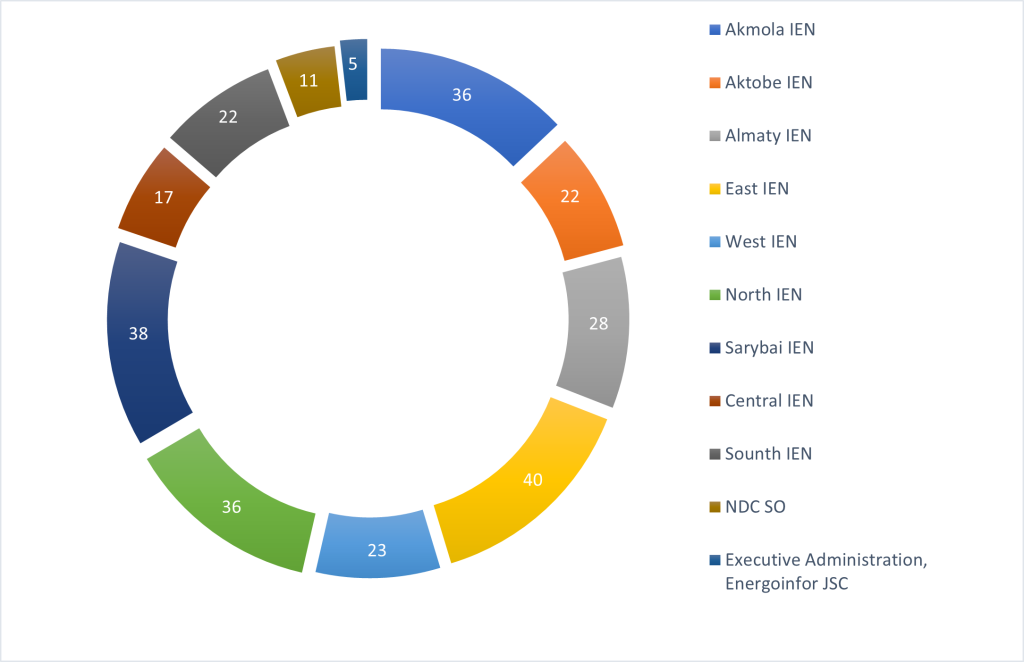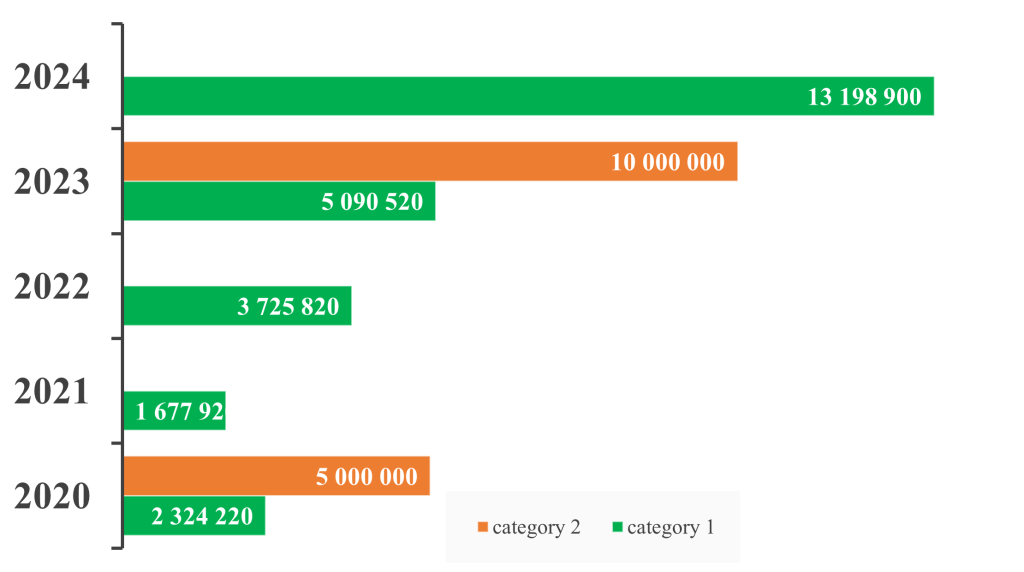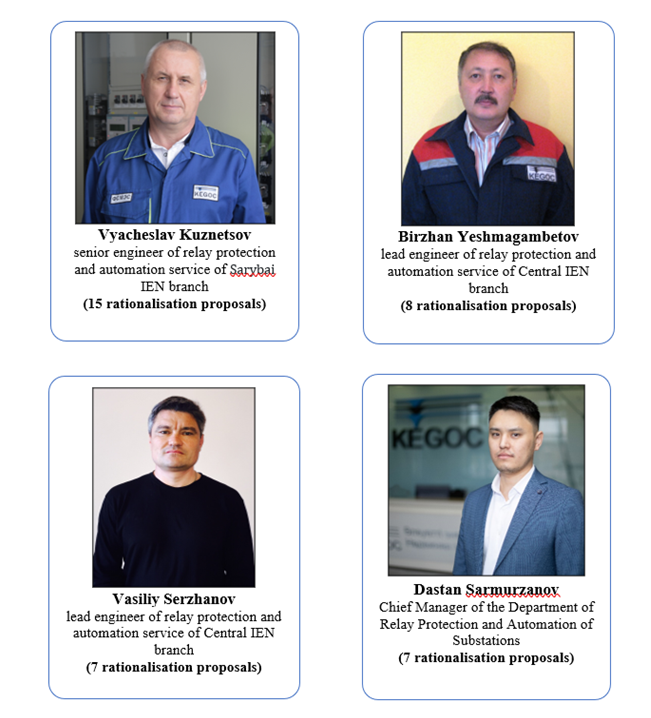Rationalization and inventive activity (hereinafter referred to as RIA) in KEGOC is aimed at achieving the strategic goals of the Company in accordance with the Development Strategy of KEGOC and the Innovation and Technology Policy of KEGOC.
The key advantage of RIA is the potential for each employee to participate in this process, which allows you to reduce the period from conception to execution of the idea and cover the maximum number of Company employees.
As part of the RIA, concepts are recognised with the possibility of application in other departments of the Company, and terms for scaling the offer are presented.
The main goals in organizing RIA are:
1) activation of RIA and further development of mass technical creativity of employees of the Company and subsidiaries;
2) increasing the interest of employees of the Company and subsidiaries in the results of their work through moral and material incentives for RIA.
Statistics of rationalization proposals
For the period 2013-2024 278 applications were recognized as rationalization proposals.

Note:
NDC SO - national dispatch center of the system operator;
IEN - intersystem electrical networks.
Types of rewards
Material stimulation of RIA allows to unleash the potential of human capital. The Company's employees are motivated to improve work processes, to find the best options for solving production issues.
The amount of material remuneration for the implemented rationalization proposal is determined in two categories:
1) The first category contains rationalisation initiatives that have no or little economic impact. These are rationalisation suggestions, the implementation of which is predicted to have no economic impact or to have an economic impact of up to KZT 5,000,000 (five million tenge). The payment for first-category rationalisation proposals is calculated in accordance with the RIA Rules and cannot exceed MCI 520 (five hundred twenty monthly calculated indexes).
2) The second category covers economic rationalisation initiatives. These are rationalisation plans, the economic impact of which will be KZT 5,000,000 (five million tenge) or more. The remuneration for rationalisation suggestions in the second category is 20% of the real yearly income / savings, but not more than KZT 10,000,000 (ten million tenge).
The amount of remuneration for rationalization proposals in the period 2019-2024:

The maximum amount of remuneration of 10 million tenge was paid in 2023 for the implementation of the rationalization proposal “Improving the reliability of power supply to the Kostanay power plant” to Sarybai IEN branch of KEGOC.
Within the framework of this rationalization proposal, a technical solution was developed for organizing emergency control automation and organizing the automatic commissioning of additional lines during repair and emergency shutdowns. The economic effect from the introduction of this rationalization proposal is 68 million tenge.
The best rationalization proposal contest
The competition is held to motivate innovators within KEGOC and its subsidiaries and to encourage employees to engage in innovation and invention activities. It is conducted annually, with the primary goal of identifying the most effective proposals and rewarding distinguished contributors.
According to the decision of the Committee for Innovation and Technological Development under the Scientific and Technical Council of KEGOC, the preliminary results for 2024 have determined the winners of the competition as follows:
1st place - Utilisation of the CSD100 device activation function for controlling the switching moment of 500 kV reactor circuit breakers (Author: Alibek Azhirov, Lead Engineer, Relay Protection and Automation (RPA) Devices Operation Group, RPA and Automation Service, Almatinskiye MES Branch, KEGOC. Co-authors: Arystanbek Seribayev – Category 1 Engineer, Monitoring and Control System (MCS) Operation Group, RPA and Automation Service, Almatinskiye MES Branch, KEGOC and Azat Boranbayev – Lead Engineer, RPA, MCS Operation Group, RPA and Automation Service, Almatinskiye MES Branch, KEGOC).
2nd place:
- Additional control scheme for heating gas-insulated tank circuit breakers EV-110/220 kV (Co-authors: Yerzhan Kuderbayev – Chief Engineer, Severnye MES Branch, KEGOC, Denis Yevdokimov – Senior Engineer, RPA and Automation Service, Severnye MES Branch, KEGOC and Eldar Zakirov – Category 1 Engineer, Lines and Substations and Electrical Equipment RPA, Severnye MES Branch, KEGOC).
- Compensation system for thermal expansion of transformer oil volume in the coupling transformer TMG-1000/10-UKHL1 during temperature fluctuations and ensuring stable pressure in the transformer cooling system during operation (Co-authors: Aleksei Polyantsev – Head of Substation Service, Vostochnye MES Branch, KEGOC and Konstantin Matiyenko – Equipment Maintenance and Repair Foreman, Substations, Vostochnye MES Branch, KEGOC).
3rd place:
- Polymer insulator spacer to prevent conductor from pressing against the line tower body elements (Co-authors: Dauren Sultangazy – Head of Tsentralnye TES, Almatinskiye MES Branch, KEGOC, Temyrlan Demessinov – Chief Engineer, Tsentralnye TES, Almatinskiye MES Branch, KEGOC).
- Acoustic signalling system to alert erroneous removal of mesh enclosures from the cable compartment of a 10 kV switchgear bay under voltage (Author: Marat Nurpeissov – Head of 500 kV Semey Substation, Vostochnye MES Branch, KEGOC. Co-author: A.K. Mukazhanov – Substation Maintenance Electrician, 500 kV Semey Substation, Vostochnye MES Branch, KEGOC).
- Implementation of remote access and time synchronisation for RPA (Siprotec) terminals installed at third-party substations (Author: Nursultan Yessensariyev – Category 1 Engineer, RPA, MCS Operation Group, Substations, RPA and Automation Service, Almatinskiy MES Branch, KEGOC. Co-author: Azat Boranbayev – Lead Engineer, RPA, MCS Operation Group, RPA and Automation Service, Almatinskiye MES Branch, KEGOC
Contributor: A.A. Falomeshkin – Head of IT Department, EnergoInform Branch, Almatinskiye MES Branch, KEGOC).
More than 342 employees of KEGOC and its subsidiaries actively contribute to innovation and invention activities. The most engaged innovators include:
